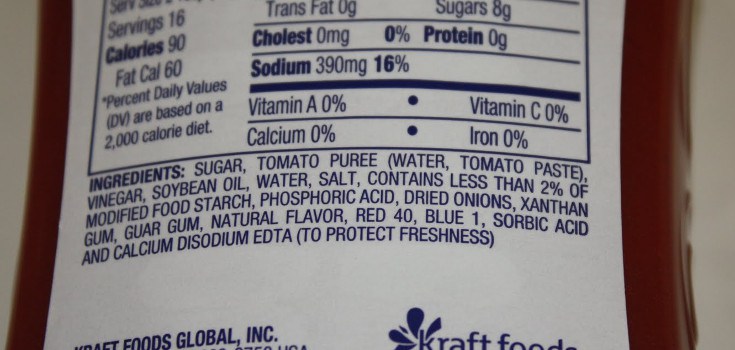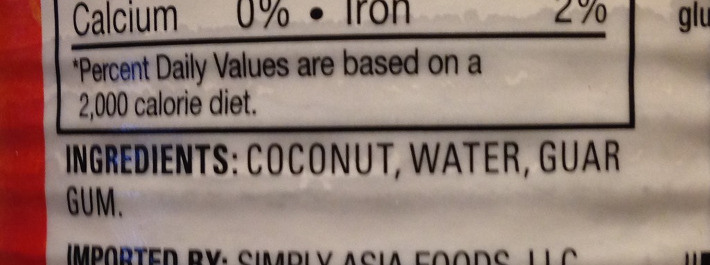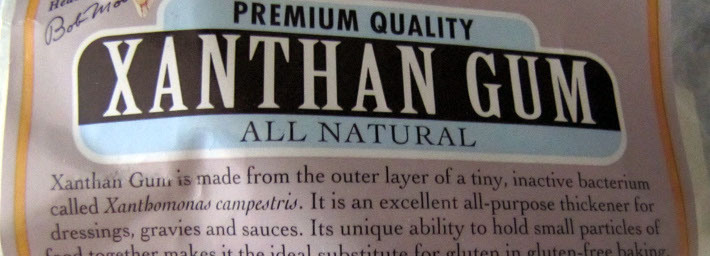5 Indigestible Gum Ingredients Used in Processed Foods
- Details
- Written by AndEl

It can seem laughable in today’s world when a food manufacturer advertises his product as ‘Real Food.’ The truth is that more and more of the grocery items we used to take for granted as being real food are no longer so real. One of the latest of many examples of this is the substitution of indigestible gums for the healthy fats people have counted on for eons.
Why would a manufacturer deliberately add indigestible gum to food?
Three reasons:
- The use of gums makes foods feel thicker, creamier, and richer, and therefore more appealing and more likely to be purchased.
- Gums stabilize foods so they can maintain consistency while sitting packaged in a grocery or convenience store for months.
- Gums cost less than the real food ingredients they are replacing. This means higher profits for food manufacturers.
Many food products have silently been reformulated over the past hand full of years to include various gums. If your favorite foods just don’t taste the way they used to, or the texture is a little bit off, the switch to gum may be to blame. Though taste and texture differences are only the beginning of the gum story.

Gums are polysaccharides, a form of carbohydrate, newly derived from bushes, trees, seaweed, or bacteria. The important thing here is that in the course of human evolution, gums have never been consumed before by people, and the body has never learned how to process them.
Think about nightshades as an example, one of the most recent groups of plants to be added to the diet of humans. These include tomatoes, potatoes, peppers, and egg plant. Many people still have difficulty processing nightshades – and they have been included in human diets since the 1500’s. It’s the same thing with corn. Maybe in 600 years we will have adapted to gums, but as of now, they create little but misery in the human body
Eating food containing gums can lead to flatulence, bloating, diarrhea, and other things too gross to mention here. It can make you feel like your intestinal tract is packed with cement, and sound like rolling thunder clouds. The affect is as though you have taken a heavy dose of a laxative at the same time you have sat down to dinner, and your body is totally confused. This is why it’s important to avoid these ingredients whenever possible.
But avoiding these gum ingredients is easier said than done, as gums are now in almost every kind of processed and prepared food. This is how it is whether you shop at upscale, healthy image grocers, or the usual supermarkets, and it is an excellent reason to give up processed foods.
Here are 5 Gum Ingredients to Look out For
1. Tara Gum
Tara gum comes from the seeds of the Tara tree via bacterial fermentation, and is probably the latest gum to appear on the scene. It’s the gum used to replace most of the healthy fat in Breyers ice cream. Public outcry over the change in taste and texture is the reason that today Breyer’s sells for about half the price it did before tara gum came along. But while the company recently announced a switch to milk free of growth hormones, it refuses to budge on the gum.
2. Xanthan Gum

Xanthan gum is synthesized from bacteria for its binding properties in breads and other baked goods. It’s also found in condiments, salad dressings, puddings, frosting, yogurt, soups, sauces, gravies, frozen entrees, processed meats and even pharmaceutical drugs and supplements.
Derived from corn, wheat and soy (mostly GMO), xanthan gum can cause allergic reactions, mysterious migraine headaches, and skin rashes. It has been linked to illness and death in infants, and the FDA has issued a warning to avoid giving infants anything containing xanthan gum. The FDA has also issued a press release stating that xanthan gum may cause necrotizing enterocolitis, the death of intestinal cells.
The laxative effect of xanthan gum can be intense. In a study of people taking 15 grams of xanthan gum for 10 days, it was determined to be an effective laxative. Some participants reported bloating and diarrhea with smaller amounts. It is not difficult to consume 15 grams of xanthan on any given day because it is so ubiquitous.
3. Guar Gum
Guar gum comes from the endosperm of guar beans, and can be found in the same items as xanthan gum. Guar gum may be even more upsetting to the digestive tact that xanthan because it forms a voluminous gel that forces intestinal content along, creating cramping and discomfort in the process. When study participants were supposed to consume 21 grams daily for a three month period, several dropped out complaining of pressure in the intestinal tract and bloating.
4. Carrageenan
A gum that comes from red algae, carrageenan can be found in dairy products and processed milks made from soy or almond. It is used liberally in baked goods. Although there has been little testing in humans, one study concluded that carrageenan may induce inflammation. Studies with animals found that carrageenan can cause intestinal damage that includes loss of epithelial cells, increased permeability (what leads to leaky gut syndrome), bloating, discomfort, and diarrhea.
Concerningly, carrageenan can also be found in organic food.
5. Tragacanth Gum
Tragacanth gum, which comes from plant sap, is also widely used. It is capable of causing severe allergic reactions. Symptoms include mood and behavior changes, numbness, runny nose, watery eyes, and lip or tongue swelling. Of course this is on top of the intestinal effects mentioned above.
There are others gums in our food. If you have not been label reader, this may be the time to start.

Source Here
Liked this article? Dive deeper into personal growth and wellness! Check out CrystalWind.ca for spiritual wisdom or explore AromaWorx.ca for natural well-being tips. Spread the positivity—share this with friends on their happiness journey!
Let’s Chat! Drop Your Thoughts Below! ![]()
Disclaimer Health
All post and information provided within this blog is for educational and informational purposes only, and is not to be construed as medical advice or instruction. No action should be taken solely on the contents of this website. Please consult with your healthcare professional before making any dietary or lifestyle changes or taking supplements that may interfere with medications. Any products or information discussed are not intended to diagnose, prevent, treat or cure any illness, disease or lifestyle. Please consult your physician or a qualified health professional on any matters regarding your health and wellbeing or on any opinions expressed within this website.
Latest Articles
Dive into the Mystical World of the Crystal Wind Oracle Deck!
Get All the Enchanting Details Now!
NEW Expanded Boxed Edition!
Now with 58 Cards for Richer Wisdom!

Imagine a world of inspiration and healing, free for all—made possible by YOU!
Donate Now—Ignite the Magic at CrystalWind.ca!

Epilepsy - Finding A Cure
Your donation can make a difference!
Help us find a cure – donate now!
Unlock Your Light: Join Lightworkers Worldwide on CrystalWind.ca!
Follow Us!
Featured This Month
Chalcedony
The Stone Of Orators Chalcedony was very popular as a decorative stone in ant... Read more
Egyptian Zodiac/Astrology
Egyptian astrology was one of the earliest forms of astrology. The Egyptians w... Read more
Lugh - Celtic God Of The Sun
The god Lugh was worshiped in Ireland as a deity of the sun. This connection... Read more
Abalone Shell
Echos Of The Ancestors Abalone strengthens the structure of the body and th... Read more
Sun in Cancer
Cancer Sun Sign Characteristics Overview The name "Cancer" comes from Latin, ... Read more
Lammas by The Hedgewitch
Although in the heat of a Mid-western summer it might be difficult to discer... Read more
Cancer Mythology
The Mythology of Cancer: A Celestial Tale of Loyalty and Sacrifice Among th... Read more
































































































































































